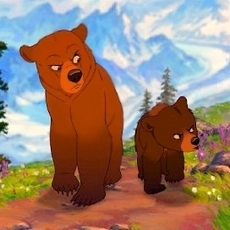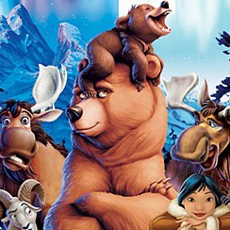Walt Disney Pictures (November 1 2003), Walt Disney Home Entertainment (March 30 2004), 2 discs, 85 mins plus supplements, 2.35:1 anamorphic widescreen, Dolby Digital 5.1 and DTS Surround, Rated G, Retail: $29.99
Storyboard:
Brother Bear’s story is pure Lion King-meets-Pocahontas, starting off soon after the Ice Age, where we find three new-agey brothers, Sitka, Denami and Kenai, sharing an adventure. It’s the time when Kenai, the youngest, is to receive his “Totem”, an animal representation to which his character’s spirit is closely tied. Out on a hunt, Sitka is killed by a bear, and Kenai, trying to prove himself to the tribe, goes out alone to find and kill it. As he does, the Great Spirits of the sky step in, transforming Kenai into a bear himself, so that he can see the world through the other creature’s eyes. Meanwhile Denemi, convinced this “new” bear is responsible for also killing the missing Kenai, vows revenge and sets out to slay him, not realizing that it is really his younger brother. Kenai has to overcome his prejudices and team up with Koda, an orphaned cub who is the only one who knows the way back to where the Great Spirits can return Kenai to human form. Throughout their journey, and as they get closer, Koda tries to share the meaning of brotherhood with his new found friend, while Kenai must decide on his future and when to tell Koda a dark secret: that it was him who killed the younger bear’s mother…
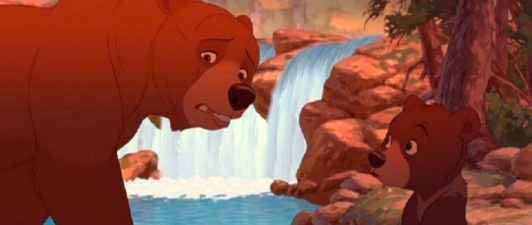
The Sweatbox Review:
If things had gone as originally planned, Brother Bear would have followed Home On The Range into theaters and ended up being the last (for a while at least) traditionally produced animated film to come from the Disney Studio. But the powers that be from Disney on high commanded that the film be shorn of six-months production time and rush-released to coincide with the DVD and home video release of The Lion King last fall, in a desperate bid to create company synergy. Hey, both stories featured talking animals in the wild, right? Both had a stampede sequence? Music and songs from older British rockers? Check! If people saw the Brother Bear trailer on the Lion King release, they’d go see it instead of a singing cow comedy, right? Well, kind of.
Actually, I’m pretty thankful that Brother Bear got shunted up ahead, as it means that the final 2D, hand-drawn Disney animated feature (for now at least) will end up being a big, bright, colourful, musical comedy (scored by Alan Menken, no less), very much created in the classic mould, and with designs that re-capture the 1950s look of Disney animation. It’s a shame that the tally only made it to number 44, though I’m sure if one counted all the “ancillary” animation released, (including Duck Tales The Movie, A Goofy Movie and even Teacher’s Pet), you’d find yourself way above 60. At least, with those balladeering bovines, it means that classical Disney Animation will go out with a raucous bang, rather than the slight whimper that it would have had with Brother Bear, and also with a film created at the original Burbank Studio, rather than a satellite spin-off.

There’s no actual problem with the entertainment that Brother Bear provides, though after the drama-lite of Mulan and the outrageousness of Lilo And Stitch, the film does bring the folks at Walt Disney Feature Animation-Florida back down to Earth with a great big thud. The film is more steeped in the “serious, epic art” phase of mid-90s Disney rather than the fresh knockabout feel of 60s Disney or even the films of the late 80s and early 90s. In fact, going back to that corporate synergy approach, it sometimes seems the film has been stitched together from successful elements from Disney’s past.
Brother Bear is very much a film of two parts. Not quite two halves, since the split doesn’t seem to be equal. There are a variety of changes that happen throughout the story, which actually work in the film’s favor, as well as against it. First and most noticeable is the switch from traditionally animated 1.85:1 aspect ratio to the full 2.35:1 look of CinemaScope, which accompanies Kenai’s transformation from human to bear. This is the first example of a ratio change in an animated film, though live action films have been doing it for years (even as far back as MGM’s heyday, though Galaxy Quest comes most recently to mind). The actual change is handled well, though I was expecting the screen to stretch wider DURING the actual change. That it waits until after the event, when Kenai awakes the next day, dimmed the effect of this moment for me ten-fold. What was also noticeable is the overall change in color palette after the switch to the wider-screen. Colors, supposedly because Kenai is now more at one with nature and therefore experiencing things with added detail, take on an almost mind-numbing brightness, and despite an attempt to be bold, the backgrounds began to look quite bland to me, almost approaching the overly exposed look of a DTV release.

Other changes that somewhat break the spell the film has on the audience up to this point also include the overall tone, which goes from that “serious, epic art” approach from human-Kenai’s screen time to a much more cartoony feel. The characters are fluffier, with rounder designs, and their attitudes change too. This is primarily again because the bear-Kenai is experiencing these moments from the other side of the fence, where he can see what human-kind can do to the peaceful, fun-lovin’ naturalness of the animal world. There’s also a great deal more reliance on comedy than from the opening human sections, and while all these switches do help in putting you in Kenai’s place, the fact that there are so many of them hurt the basic structure, almost becoming another type of film entirely until the wrap up at the end.
It’s also almost a case of Disney-by-numbers. The opening human sections are great, re-treading Pocahontas ground with mystical stories and elders who continue the legacy of their people, in this case Eskimos. There is, in truth, some fine story work being told here, and animation which really shows how the team at WDFA-Florida have come on since working on those Roger Rabbit shorts in the 1990s (Kenai’s brother Sitka’s face just before he makes a fateful decision is the stuff of what just makes Disney “Disney”). But against that, there seems to be an over reliance on tricks (comedy sidekicks, music montages, etc) that have helped previous Disney film scrape through, and here in Brother Bear they manage to stick out somewhat more than usual. There is one cringe-worthy scene where, for no apparent reason, new-found-friend moose Rutt and Tuke decide to accompany Kenai and Koda on their quest, and I shuddered at the thought of the old comedy shtick playing throughout the rest of the movie. However, they come and go, just at the right time funnily enough, and the never get irritating (though I’d have loved to see more of the similar ram duo characters).
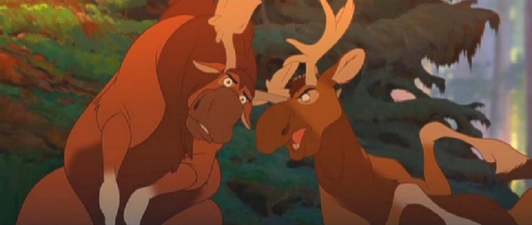
Phil Collins doesn’t really help things feel fresh in the way Tarzan felt different and unique, though he does provide several catchy tracks that help tell the story through song. For the first time, he’s also co-written (with Tarzan composer Mark Mancina) the original score, leading to a tight weaving of song and score. To be honest, I found that some of the lyrics were bordering on the trite, with none of the depth that I felt propelled Tarzan up to the next level. That said, musically the songs are great, powered by Collins’ usual thumping rhythms as you might expect from an ex-percussionist, and surely the middle-eight from Welcome (“to our family…”) is one of the most beautiful and touching of any in the Disney canon. Good to see too that, although Collins wrote all the songs, he shares vocal duties with others, most notably Tina Turner, who sings the film’s opener. It may seem an obscure choice to have someone else sing this one song when Phil dominates so much of the rest of the soundtrack (and many fans were saddened that his version, heard in early teaser trailers, wasn’t used in the final film) until one comes to realize that it helps the transformation divide even more by not having him come to the fore until Kenai is a bear. Subtle, and nicely played.
The voice cast on the whole do really good work as well, particularly for such a group of well-known stars. Unlike such films as Sinbad: Legend Of The Seven Seas, or Shrek, the voices don’t overbalance the characters, with even Rutt and Tuke escaping being weighed down by their famous Canadian counterparts, Rick Moranis and Dave Thomas of the McKenzie Brothers fame. In the lead role of Kenai, Joaquin Phoenix is spot on, while one thing I did notice this second time around was how very few female characters there are in Brother Bear, leaving no room for any love interest subplots.
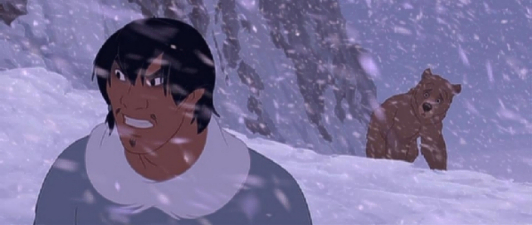
I don’t want to take anything away from Brother Bear as a movie, as it is thrilling entertainment and will certainly be enjoyed by its audience. On seeing it again, I was touched this time in several scenes, but it did still feel terribly “tried and tested” throughout. The transformations that occur roughly half an hour in really do lift interest at that point, though the ending, where Kenai must make a final choice, seemed not only predictable but contrived also.
But this is from someone viewing Disney’s 43rd animated film after watching recent offerings so intently, so there is bound to be a little overlap between films. Those looking for Disney’s unique quality of storytelling, traditional animation technique and all-round entertainment will not be disappointed, and die-hard fans should have no hesitation in adding it to their collections.
Is This Thing Loaded?
Another Disney set that expands itself to two discs by providing a second version of the film, though in this case it’s an interesting addition, as you’ll read below. As with many two-discers of recent months, I’m not sure if this isn’t really a single disc in disguise, but given the almost-legitimate alternate transfer and the DTS track on the other, it would have been a awfully tight squeeze to get this all onto one disc without severe compression artefacts in the image section. So let’s see what we have to fill out the space…
First off, and probably most exciting, is a Sneak Peek at Disney’s first fully digital animated movie, Chicken Little, out in theaters in 2005. On the basis of this teaser, I can honestly say that average audiences won’t be able to tell the difference between the style of this film or those that Disney makes with Pixar (it has the same zippy style and overly “smart” dialogue), although I found the scripting a little “obvious”, the animation just so-so (probably on par with the first Shrek), that the lip-sync isn’t quite there yet, and the voice for the lead character to be all wrong (though it grew on me and I’ll be ready for it come next year). But there you go, and I shan’t continue reviewing what is essentially a trailer any longer!

Other previews, also accessible from the Sneak Peek menu, include the Aladdin PE, The Incredibles teaser, Mickey’s Three Musketeers, the upcoming Mary Poppins SE, and Mulan II (where not only does Mushu not sound like Eddie Murphy, but all his dialogue sounds more muted and less crisp than anyone else). There are also promos for the Brother Bear Gameboy Advance title and Walt Disney World.
The main bonus (and perhaps only real reason for watching the 1.66:1 formatted version of the film), is Rutt And Tuke’s Commentary. Via seamless branching, the DVD will flip into secondary angle mode, where silhouetted outlines of the two moose characters (rendered in CG) appear, Lion King 1½ style, to talk the audience through the movie. Cutting down tremendously on how much time, effort and money it would make to create a real Brother Bear 1½, the commentary is pretty fun, though how funny you find it will rely deeply on whether you can stand vocalists Rick Moranis and Dave Thomas speaking babble for an hour and a half. I’ve been a fan of theirs since the McKenzie Brothers era, and never felt they got the just recognition for pioneering the brand of humor that Mike Myers used (combined with Bill And Ted’s “inspiration” also) for Wayne’s World. In the movie, they’re fun, but even I found their improvised commentary yakking fairly tiresome. Character chats have never really been my thing, but they do actually let you in on a few pointers on the film’s creation, though it’s mostly filler (for every valid point they make, there are at least 20 or so humorous faux comments, such as “hey, is that Yoda?”), and I was disappointed to see the much vaunted “see them onscreen” hook only used sporadically through the feature.
One nice touch, as with the Finding Nemo DVD, is the “invisible” running times for each feature that pop-up when highlighted. If only more discs would include this as a feature, especially audio-only programs, or video clips that don’t display their lengths on the counter. The menus on the disc are pretty fun themselves, featuring Rutt and Tuke again and their madcap brand of humor. Koda’s Outtakes (2:35m) features more of the same as found in the closing credits, but this time more centered on the fluffing of lines and scenes going awry. Created in the Pixar tradition (which itself was pioneered in an earlier Warners Bugs Bunny cartoon), I found the clips funny, but with too much of the “crew” having a say. Although the “crew” is heard occasionally in the Pixar outtakes, practically every shot here has a cry of “marker” and “err, can we fix that please” at the front and end – a little off putting, which impacted on the humor for me. The clip is presented in 2.35:1 letterboxed widescreen, which actually looks like it’s cropped a little north and south, though what’s nice is that these are fully animated shots.
Lasting four minutes, the Phil Collins Look Through My Eyes music video is a much better proposition than many of Disney DVD’s music clips, which sometimes only last for a matter of seconds. Here, we get the full song, with a typically well-produced video promo that shows Collins recording the song as well as a healthy amount of shots from the movie. The clip is shown in letterboxed 1.85:1, with a small reminder that the soundtrack is now available. There’s more music with the On My Way sing-along, which plays the four minute clip with the words on screen to, hey, sing along with. Though it isn’t anamophically enhanced, the lack of edge-enhancement on the clip actually produced a “cleaner” image.
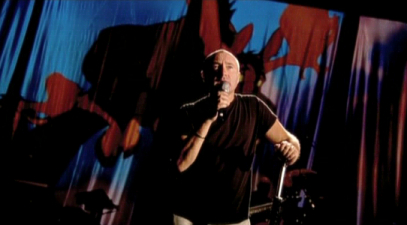
Bear Legends is a brief three-minute collection of Native American Tales, with Tanana telling us such myths as How The Bear Came To Be, and The Boy Who Lived With Bears. Nicely rendered in stone wall paintings, the feature has little to do with the film, but shares themes and its visual approach. Talking of visuals, the ten-minute Art Review has art director Robh Ruppel and Bear-Kenai animator Byron Howard narrating a montage of photos and concept art stills, and showing the evolution of the film and its art. In an early version of the film, an older bear named Grizz was to be Kenai’s guide, which might have taken off the curse of the perhaps too “kid-friendly” Koda sidekick and made it a deeper film. Although the clip is video based, the viewer can pause it at any time to take in the character designs and paint work that went into the production. The clip is nicely put together, and I found it a really great way to step through the images, and the added commentary opens up a lot more than what can be taken in simply by sifting through images alone.
And moving from the visual side to the audio, The Art Of Foley is a quick look (3:15) at how the sound effects for an animated movie are put together, hosted by Jeremy Suarez (“kid-friendly” Koda). What starts off as being dangerously close to turning into fluff (and I’m not talking bear fur here!) actually plays as a pretty fun little excursion into the sound studio, and those who have always wondered where “Foley” got its name from will find the answer in here!
Wrapping up Disc One are a couple of Brother Bear games. I actually found these rather sweet, and well in keeping with the themes of the movie. In Bone Puzzle, hosted by Sitka, the player must select the bone shapes to put together a representation of an animal’s paw-print. On successful completion, Sitka will play an informative clip (created using Disney’s extensive library of animal clips) all about that animal. It’s quite good fun and little kids will enjoy it while learning about the wildlife seen in the movie. With the Find Your Totem game, Tanana asks various questions to find out which animal you would be on a Totem Pole. Not as much fun as the animal bones, this was put together nicely, though took a little while to get through. Kids will probably love it though, if they stick with it (I was a salmon – “enthusiastic and generous”)!
On to Disc Two, and even from the menus, it’s clear that this is the more “grown up” disc of the two, with its epic design (with different looks for the bonus and scene selection from the first disc, so one can not complain that it has been skimped on). The majority of space is taken up with the true widescreen transfer and the superior DTS track, but there are a smattering of extras that will please long-time Disney box set fans. Paths Of Discovery: The Making Of Brother Bear is a series of featurettes, grouped under four categories: Beginnings, Welcome To The Family, Mirror To The World and Music And Songs. There’s a handy “play all” option, which runs all the pieces as a seamless 45-minute documentary, which seems the best way to watch it.
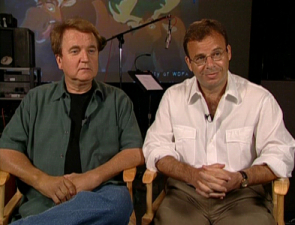
It’s a really good piece, which doesn’t gloss over the production process, though understandably the troubles at the Florida Studio are left untouched. We get to hear mostly from directors Aaron Blaise and Robert Walker (perhaps they have said what they wanted to here, hence no commentary), as well as Phil Collins, the voice cast and, somewhat surprisingly, from Roy Disney, who is still credited as Vice Chairman of The Walt Disney Company and Chairman of Disney Animation in his clips. Much discussion is had over the story origins, the directions the film went in, the planning of the songs and score, and on “how great” Michael Eisner’s “hands on” approach helped shape the film and “made it better”.
The rest of the disc is pretty much dedicated to Deleted Scenes and Alternate Songs. There are three deleted sequences, shown in storyboard and rough animation, and lasting just over eleven minutes with an introductions from the filmmakers. Again, there’s a “play all” option, which makes things a little easier to navigate. The scenes range in length, but are all pretty long, though reasons why they were either shortened or deleted are clear.
There’s also a deleted song, The Fishing Song (3:45m), which was later changed to the Welcome track, and that would have played where Kenai meets the other bears at the salmon run. Presented against storyboarded art, the song features temp track vocals and some audio spots, and is very much in the same vein as the more rambunctious sections of Welcome, but lacking that effective middle-eight which brings it all home for Kenai. A fun enough track, but wisely switched for the more majestic track featured in the movie. Finally, we also have the Transformation song, as written by Collins (2:25m). In the movie, the English lyrics were translated into Innuit and sung by the Bulgarian Women’s Choir, but here we have a chance to see (via subtitles) what the lyrics were as originally written. It’s presented as a music video, with scenes from the film played against clips of the Choir in the recording studio, and very interesting in its own right.

If I could have asked for any more, it would be for the theatrical teaser and the two full trailers that warmed audiences up to see the film in theaters. At the very least, I guess, these are available on other Disney DVDs in various configurations, but it would have been nice to have them bunched with the feature. However, as always, Disney seems not to want to include such things on certain titles – a mystery to me. Also, it would have been great on the second disc to hear from the filmmakers with their own “serious” commentary. As I understand it, directors Blaise and Walker are still signed to the Studio, unlike the majority of people who worked on Brother Bear (ouch!), so they would have probably been available. Perhaps the choice was for the space to be taken up with the DTS track, but my feeling is that the French language track could have been substituted for another bonus, especially since it is available on the alternate transfer.
Finally, oh Brother – where art thou DVD-ROM content? Nowhere, just a link to register the disc and the usual Disney interface.
Case Study:
Forgoing any deluxe treatment, Brother Bear’s travels to disc don’t seem to be worthy of either a glossy slipcase or even Disney’s traditional white keepcases (though the fact that this is a 2-discer may have been a consideration). Whereas it would have been nice for Disney to support this release with a simple wraparound, they have chosen not to. However, inside are the usual kinds of saving coupons and inserts we’ve come to enjoy on titles such as these, including a DVD Guide that folds out to present a “tree map” of what – and where – things are on the discs.
Ink And Paint:
There has been a review or two that have taken the video on Brother Bear to task for being slightly soft. As I originally saw it in theaters, I can say that the film does have a very “warm” palette and a rounded look to it, and I was interested to see how it would look on video. As far as I can tell, this is a faithful representation of the film on the whole, and being a digital-to-digital transfer, looks great (though I did notice that edge-enhancement rears its ugly head to try and give the film more definition). We get two transfers, amazingly neither of which has been butchered into a fullscreen version! On Disc One, there’s a “family friendly” widescreen version, which crops a slight sliver of image left and right to give a 1.66:1 presentation. When the film widens to its hard-matted 2.35:1 ratio, we lose much more of the composition, as the frame stays put at 1.66, panning-and-scanning the wider ratio for picture information. This is actually a fairly nice way to present the film, since it retains a consistent screen dimension, while not completely shaving the film of its overall look.
On the other hand, Disc Two takes the original theatrical ratio approach. The big question was whether we would get a full 16×9 frame opening and then change to 2.35:1 (therefore reversing the intention of the filmmakers by actually shrinking the frame within the 16×9 frame), or would we truly get the film as shown in theaters? Happily, I can report that we get the film as was intended, with the opening sequences (in correct 1.85:1) printed WITHIN the 2.35:1 ratio. Thus, the opening of the film will appear “windowboxed”, with “black bars” all around, until the image widens out after the transformation. On a standard TV, I can see how this might be annoying (hence the alternate transfer), but blown up on a 16×9 set or even better on a front projection system, and it’s just like being at the theater, since the image really does broaden out and provide more width to the vistas.

The one issue I had with the image overall was with a “banding” effect on the color grading of the bears’ fur. It wasn’t something I noticed in the theatrical release, and I checked the disc on another display other than my projection system to make sure I wasn’t seeing things and the effect was still there. It’s not a fault on the disc, and more to do with how the conversion process from the original digital files to DVD’s compression algorithms works, but in any respect, it’s something that apparently couldn’t be avoided. Perhaps it was more obvious to me watching it on a larger screen, but it should be hardly noticeable to the majority of viewers and kudos is due to Disney for treating the film with appropriate respect.
Scratch Tracks:
The video isn’t the only thing to commend on the Brother Bear disc – there’s also a wonderfully lively DTS track accessible on the correct 2.35:1 widescreen version of the movie! The fully enveloping sound mix doesn’t quite reach demo material (it’s not actually that kind of movie), though it is a very pleasing aural experience, especially when the score really kicks in, or when there is an action scene to be had. The transformation effects sound great and the bass lends a powerful punch to the more dramatic moments. The 5.1 Dolby track is almost as good, just being beaten out again by the deep bass, but still as crisp as the DTS. French and Spanish Dolby Digital 5.1 tracks are also included on the 1.66 version, as is a French track on the 2.35 transfer, with English subtitles on both.
Final Cut:
All in all, Brother Bear comes to disc in a very comprehensive package, with features put together in a classy way as only Disney can, and that will please the young and even the oldest animation nuts out there. The film may not be a classic in the true Disney sense, but has enough of the humor and heart that we’ve come to expect from the recent films from the Studio that it is able to stand on its own two (four?) legs. Those who love Disney animation will find much to enjoy, and on the strength of the supplements provided here, the film and this set are very recommended – even the more cynical among us will find things of interest.
By far the most impressive aspect of the film itself are the changes that dominate the post-transformation scenes, and though this DVD edition may disappointing in the lack of a true filmmaker commentary, everything one needs to know is here, as well as two valid presentations of the movie. Of course, the theatrical ratio/DTS print is the one to go for, and in this case, Disney have done another fine job in preserving their artists’ work for home audiences.
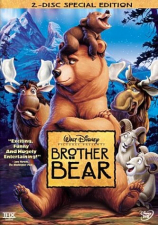 | ||
 |







